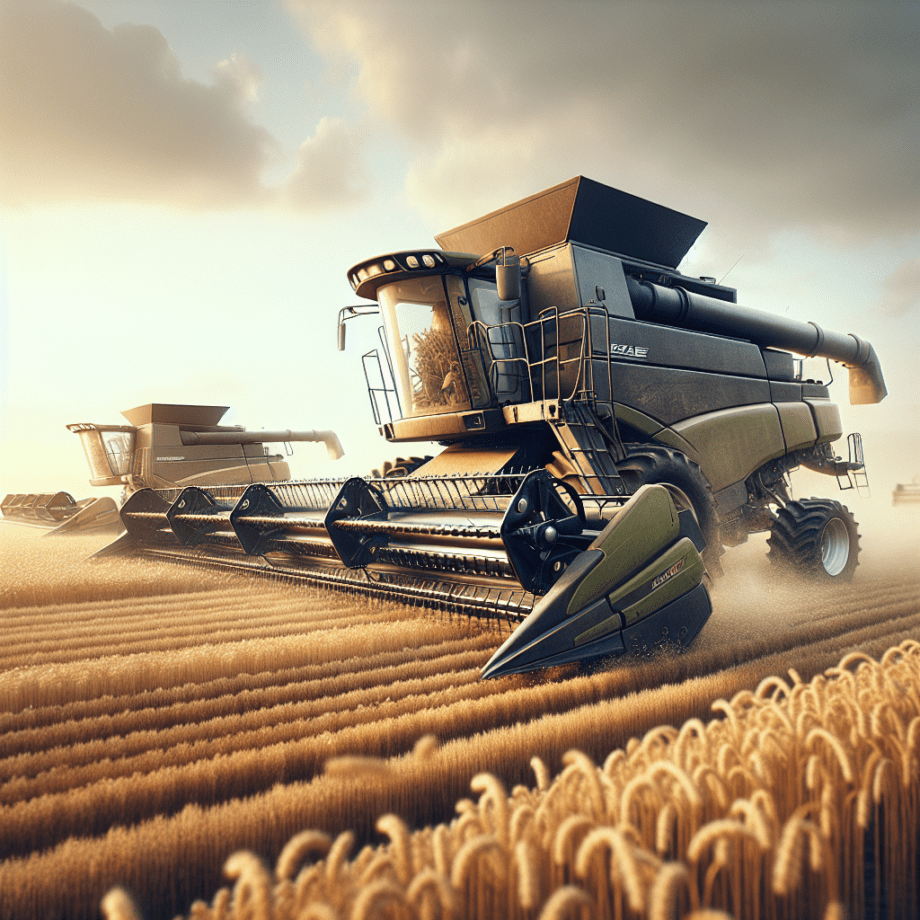Combine harvesters have revolutionized crop production by significantly increasing efficiency and productivity in the agricultural sector. These sophisticated machines integrate multiple farming processes into a single operation, making them indispensable tools for modern farmers. This article delves into the mechanics, benefits, and future prospects of combine harvesters, highlighting their pivotal role in transforming agriculture.
The Mechanics of Combine Harvesters
Combine harvesters are complex machines designed to perform three primary functions: reaping, threshing, and winnowing. These processes are essential for harvesting grain crops such as wheat, barley, and corn. The integration of these functions into a single machine has drastically reduced the time and labor required for crop harvesting.
Reaping
The reaping process involves cutting the crop and gathering it into the harvester. Modern combine harvesters are equipped with advanced cutting mechanisms, such as rotary or reciprocating blades, which ensure a clean and efficient cut. The header, which is the front part of the combine, is responsible for this task. Different types of headers are available, each designed for specific crops and conditions.
Threshing
Once the crop is cut, it is fed into the threshing drum, where the grain is separated from the stalks and husks. The threshing drum rotates at high speeds, using a combination of friction and impact to dislodge the grain. This process is crucial for ensuring that the maximum amount of grain is collected with minimal damage.
Winnowing
After threshing, the mixture of grain, chaff, and other debris is passed through a series of sieves and fans. This process, known as winnowing, separates the grain from the chaff and other impurities. The clean grain is then collected in a storage tank, while the chaff is expelled from the machine. Modern combine harvesters are equipped with sophisticated winnowing systems that ensure a high level of grain purity.
Benefits of Combine Harvesters
The introduction of combine harvesters has brought numerous benefits to the agricultural industry. These machines have not only increased productivity but also improved the quality of harvested crops. Here are some of the key advantages of using combine harvesters:
Increased Efficiency
Combine harvesters have significantly reduced the time and labor required for crop harvesting. By integrating multiple processes into a single operation, these machines can harvest large fields in a fraction of the time it would take using traditional methods. This increased efficiency allows farmers to cover more ground and harvest their crops at the optimal time, reducing the risk of crop loss due to adverse weather conditions.
Cost Savings
Although the initial investment in a combine harvester can be substantial, the long-term cost savings are considerable. By reducing the need for manual labor and increasing the speed of harvesting, combine harvesters help farmers save on labor costs and improve their overall profitability. Additionally, the improved efficiency of these machines can lead to higher crop yields, further enhancing their economic benefits.
Improved Crop Quality
Modern combine harvesters are designed to minimize grain damage during the harvesting process. The advanced cutting, threshing, and winnowing mechanisms ensure that the grain is collected with minimal breakage and impurities. This results in higher-quality crops that can command better prices in the market. Furthermore, the ability to harvest crops at the optimal time helps preserve their nutritional value and overall quality.
Future Prospects of Combine Harvesters
The future of combine harvesters looks promising, with ongoing advancements in technology set to further enhance their capabilities. Innovations in automation, precision agriculture, and sustainable farming practices are expected to shape the next generation of combine harvesters.
Automation and Precision Agriculture
Automation is poised to play a significant role in the future of combine harvesters. The integration of GPS technology, sensors, and artificial intelligence (AI) is enabling the development of autonomous combine harvesters that can operate with minimal human intervention. These machines can navigate fields with precision, optimize harvesting routes, and adjust their settings in real-time based on crop conditions. This level of automation not only increases efficiency but also reduces the risk of human error.
Precision agriculture, which involves the use of data and technology to optimize farming practices, is also influencing the design of modern combine harvesters. By collecting and analyzing data on soil conditions, crop health, and weather patterns, these machines can make informed decisions that enhance crop yields and reduce resource wastage. For example, variable rate technology (VRT) allows combine harvesters to adjust their harvesting speed and settings based on the specific needs of different areas within a field.
Sustainable Farming Practices
As the agricultural industry faces increasing pressure to adopt sustainable practices, combine harvesters are being designed with environmental considerations in mind. Manufacturers are developing machines that are more fuel-efficient and produce lower emissions, helping to reduce the carbon footprint of farming operations. Additionally, advancements in residue management systems are enabling combine harvesters to handle crop residues more effectively, promoting soil health and reducing the need for chemical inputs.
Another area of focus is the development of combine harvesters that can handle a wider variety of crops, including those that are traditionally more challenging to harvest. This versatility can help farmers diversify their operations and reduce their reliance on a single crop, contributing to more resilient and sustainable farming systems.
Conclusion
Combine harvesters have undoubtedly revolutionized crop production, offering numerous benefits in terms of efficiency, cost savings, and crop quality. As technology continues to advance, these machines are set to become even more sophisticated, with automation, precision agriculture, and sustainability at the forefront of their development. By embracing these innovations, farmers can look forward to a future where combine harvesters play an even more integral role in ensuring the success and sustainability of their operations.
